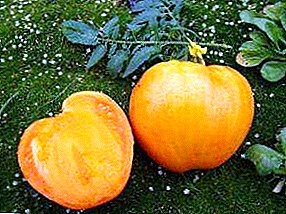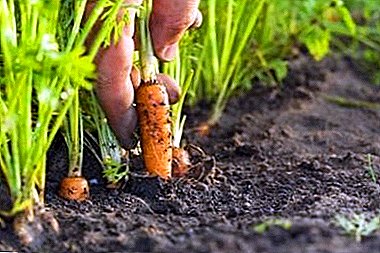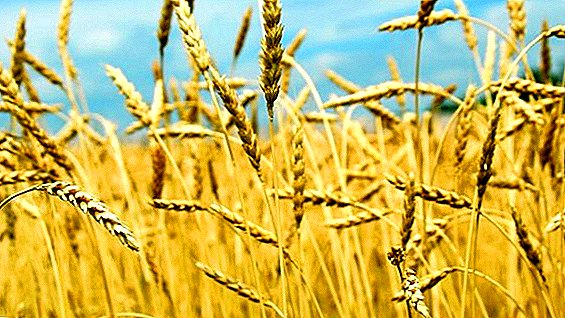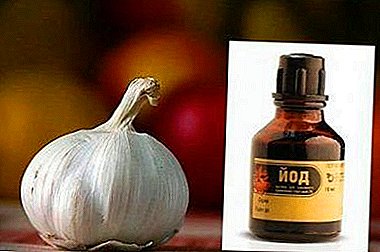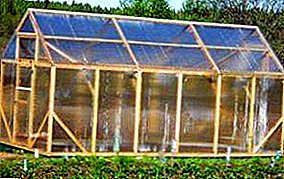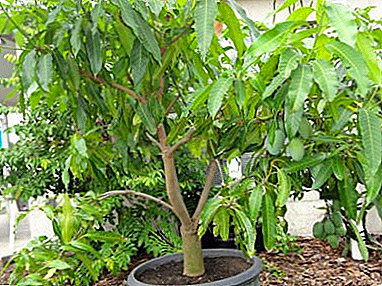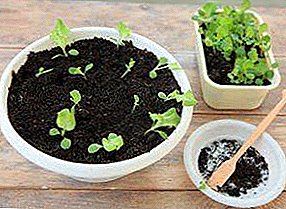
Air is a healing perennial plant. Rich in essential oils and vitamins. Used in folk medicine. It grows on moist, well-lit area.
Propagated by seeds and vegetation. Loves frequent watering and spraying.
In this article you will learn about what is Air Marsh.
general description
 Marsh Marsh or Common Marsh - herbaceous evergreen perennial. It belongs to the Araceae family. In height reaches 60-130 cm. It has wide creeping roots of a brown shade.
Marsh Marsh or Common Marsh - herbaceous evergreen perennial. It belongs to the Araceae family. In height reaches 60-130 cm. It has wide creeping roots of a brown shade.
The root system of the flower is powerful, overgrown, and spongy, with flattened cylindrical roots. Acorus rhizomes in diameter can reach 1.2-1.5 meters. Outside, Ayr root is amber-brown, inside is snow-white with a slight pink tint.
From the surface of the maternal root a large number of graceful white roots. The diameter of the cord rhizome is 45-55 cm. The calamus leaves are elongated, linear, uric, collected in thick bunches. The width of the leaves is 1-6 cm, length - 55-125 cm. The stem of the plant is erect, narrowed with sharp edges.
Flower arrow in the form of a trihedron with a groove that runs smoothly along the left side. A cylindrical inflorescence forms at the top of the arrow. It consists of miniature, compressed flowers of cubic form. On palpation, the inflorescences resemble corncobs. From their base passes the flower arrow, which grows in leafy thickets of plants. Flowers tiny, emerald-amber, are collected in small ears.
This representative of the flora is not sick and is not affected by pests. Calamus plant that is not self-pollinating. Flowering occurs at mid-end of summer. It grows in shallow water, wetlands and wetlands. It can be found along the coast, ponds, lakes. He loves swampy sunny meadows and forest edges. It grows in the central part of the Russian Federation, Siberia, the East, Asia and Kazakhstan. Homeland plants considered to be Asia. At home, keep the plant is not recommended.
A photo
The following are photos of the calamus calamus:




Home care in conditions
Consider in more detail the care of AIRA at home.
Crown formation
Mandatory pruning plant does not require. But if Air is used as an ornamental flower, then it can be shaped and trimmed faded stems.
Watering
The main feature of the cultivation of Aira is regular weeding and watering. If the plant grows on watery terrain, it is important to ensure that the water level does not dry out. When the earth coma dries out, the plant dies.
Landing
 Despite the fact that Air is a water flower, it can easily be grown on garden soil. For planting choose wet places. It is recommended to choose the place to which water will flow from the roofs of buildings.
Despite the fact that Air is a water flower, it can easily be grown on garden soil. For planting choose wet places. It is recommended to choose the place to which water will flow from the roofs of buildings.
To delay rain or thawed moisture, it is necessary to dig a 10-20 centimeter depth. DAira’s landing on ordinary garden beds is lowered. But in this case, the plant will be greatly depressed.
The best conditions for the growth of the calamus are shallow water, 4-16 cm deep. The selected place should be well lit. Also, it should have time to warm up to the growing season.
If you choose artificial reservoirs, then they should have a fertile, muddy bottom. The root system of the flower must be fixed in bottom sediments. It is strictly forbidden to fill the back of the shoot with soil. After 7-10 days should form the first escape. If the place is chosen correctly and meets the requirements of the plant, then in 3-4 years the plantation of the flower root will appear.
Important! Before planting the Airah, the bottom must be thoroughly weeded. We can not allow the plant to displace other representatives of the flora. Otherwise, Air will grow slowly, and its root system will not grow.
Transfer
In order to accelerate the growth of the plantation, the flower is regularly transplanted. To do this, the root system of the overgrown calamus is planted over a large area of nutrition. In this case, the soil should be fortified and silty. And the terrain is watery and sunny. Air looks great with Kubyshka, Nymphaea and Kaluzhnitsa.
Breeding
The sweet flag of grass-like can be propagated by dividing the bushes. The procedure is carried out in the spring or summer. It is forbidden to divide the plant in the fall, as the flower does not have time to take root. In this case, he will not have enough light, heat, and when the frost occurs, the flower will die.
Before the breeding procedure, the Aira root system is thoroughly washed from dirt and soil. The roots are cut with a sharp knife. It is important that each bush have well-grown powerful stems. The plant is transplanted in the middle of the tank or the soil for permanent growth.
Temperature
 The plant loves spring and summer. At this time can grow at a temperature of 15-25 ° C. On hot days requires careful watering.
The plant loves spring and summer. At this time can grow at a temperature of 15-25 ° C. On hot days requires careful watering.
It can tolerate heat up to 30 ° C. In the autumn and winter, requires shelter for the winter. Under a layer of mulch, the temperature should not fall below 0 ° C.
Important! Air requires shelter for the winter. To do this, use a thick layer of mulch. But the most reliable option - the growth of plants in the winter garden or greenhouse. In such conditions, you can easily monitor the temperature, which is necessary for the flower in the cold period.
Lighting
The plant loves bright natural light. It can grow in sunny glades. Maintains direct hit of sunshine. Can grow in shady thickets. But with a lack of sun, it slowly grows and practically does not grow.
Benefit
Broths from the root system of this plant is used for diseases of the stomach and liver. The plant eliminates toothache and headache. Thanks to this wonderful representative of the flora, you can cure bronchitis, asthma, depression. The plant is used in the bites of poisonous snakes. Juice of the root system improves myopia, memory, thinking, hearing.
The juice of rhizome causes smoking cessation. This representative of the flora improves the digestive system, diuresis. Ache's healing properties help to improve the liver biliary system. You can use the bath with the addition of the juice of Aira. In this case, disinfection and elimination of respiratory diseases occur.
Healing properties
 The healing properties and contraindications of the roots of the Acorus marsh are that the rhizome of the plant is rich in chemical elements. In Aire are useful essential oils.
The healing properties and contraindications of the roots of the Acorus marsh are that the rhizome of the plant is rich in chemical elements. In Aire are useful essential oils.
It is used for gallstone and urolithiasis. Flower Air drink with ulcer, gastritis and duodenal disease.
The ether of this representative flora is added to essences, compotes, preserves, syrups. Slices of the root system can be insisted on alcohol and added to dishes instead of spices. Air marsh has application in the perfumery industry and in the manufacture of household cosmetics.
Cosmetics obtained fortified suitable for use in children. Due to the chemical elements of Aira, the heart muscle is toned and the vessels are strengthened.
Use in traditional medicine
Grass Aira application is quite wide. In folk medicine, the Marsh Marsh is used to prepare tinctures from leaflets and rhizomes. They are used instead of expectorant drugs. They are used in convulsions, tantrums. Can enhance sexual function.
From the juice make lotions, decoctions. They destroy infections and lower blood pressure. With the help of this representative flora remove fungal lesions of the skin. In folk medicine, diseases of the spinal cord are treated with decoctions.
The healing properties of the calamus root calamus help to restore the loss of sensitivity. Juice washed wounds. It promotes the healing of scratches and cuts. Broth washed hair, which contributes to the strengthening and growth of curls.
Contraindications plants / root
 Aira juice is prohibited to apply with heavy bleeding.
Aira juice is prohibited to apply with heavy bleeding.
It is forbidden to use this representative flora hypotensive The plant is able to lower blood pressure. This can lead to poor health.
Air can not be used for allergies to essential oils.
The use of Aira during pregnancy and feeding is not recommended.
It is forbidden to use Air in epilepsy.
It is not allowed to use the juice of rhizomes with increased acidity of gastric juice.
Air can not be used for inflammation of the kidneys.
Calamus herb, which has numerous healing properties. Rich in vitamins and microelements. It is used in various diseases. Used in cooking instead of spices. It grows along the banks of rivers, lakes. Loves the sun, spraying, warm weather. He likes frequent transplants in fortified soil.


